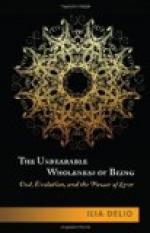If the art of miniature painting never rose—excepting in its wider consequences—to universal significance, mediaeval architecture stands before our eyes magnificent as on the first day. Until the middle of the twelfth century the monumental structures of Europe were directly influenced by the later Hellenic civilisation. The Byzantine basilica was slowly transformed into the Neo-Latin house, and thus, in this important domain also, Europe drew her inspirations from antiquity. But only the ground-plan of the Gothic cathedral, that is to say, the idea of a nave with side-aisles, was traditional and borrowed from Neo-Latin models. From this invisible ground-plan rose something absolutely original and autochthonic. This new, specifically Central-European style of architecture was developed on soil where there were no antique buildings to stem the new life with their overwhelming domination, and to bar the way of artistic inspiration with their ominous “I am perfection!” In every branch of art antiquity had proved itself a foe, until at last the Renascence was sufficiently mature to assimilate and overcome the antique inheritance so completely that it became an excellent fertiliser for the new art. The essence of the Gothic style is the dissolution of all that is heavy and material—the victory of spirit over matter. Walls were broken up into pillars and soaring arcades; monotonous facework was tolerated less and less, and every available inch was moulded into a living semblance. The result may be studied in the incomparable facades of many of the cathedrals in the North of France; and in tower-pieces almost vibrating with life and passion such as that of St. Stephen’s in Vienna. The conflict between matter and pure form is settled—for the first and only time—in Gothic architecture. The Greek temple with its correct proportions possessed no more than perfection of form without spiritual admixture; it was perfect as marble statues, which are an end in themselves, and do not point the way to spiritual truths. Gothic architecture is probably unique in its blending of aesthetic perfection of form and infinite spiritual wealth; in the fusion of these two elements in a higher intuition. It is the balance of the two characteristics of genius, inexhaustible wealth and the striving for harmonious expression. It marked the first powerful working of the Teutonic spirit on the world; its metaphysical yearning together with a genuine love of nature, found in this art its own peculiar traditionless expression, just as it found expression in the newly-evolved mysticism which no longer re-echoed Aristotle and his commentators, but drew inspiration from its own intuition. For this reason Gothic architecture never became acclimatised in Italy. The soaring tower, more especially, never appealed to the Italian architect.




